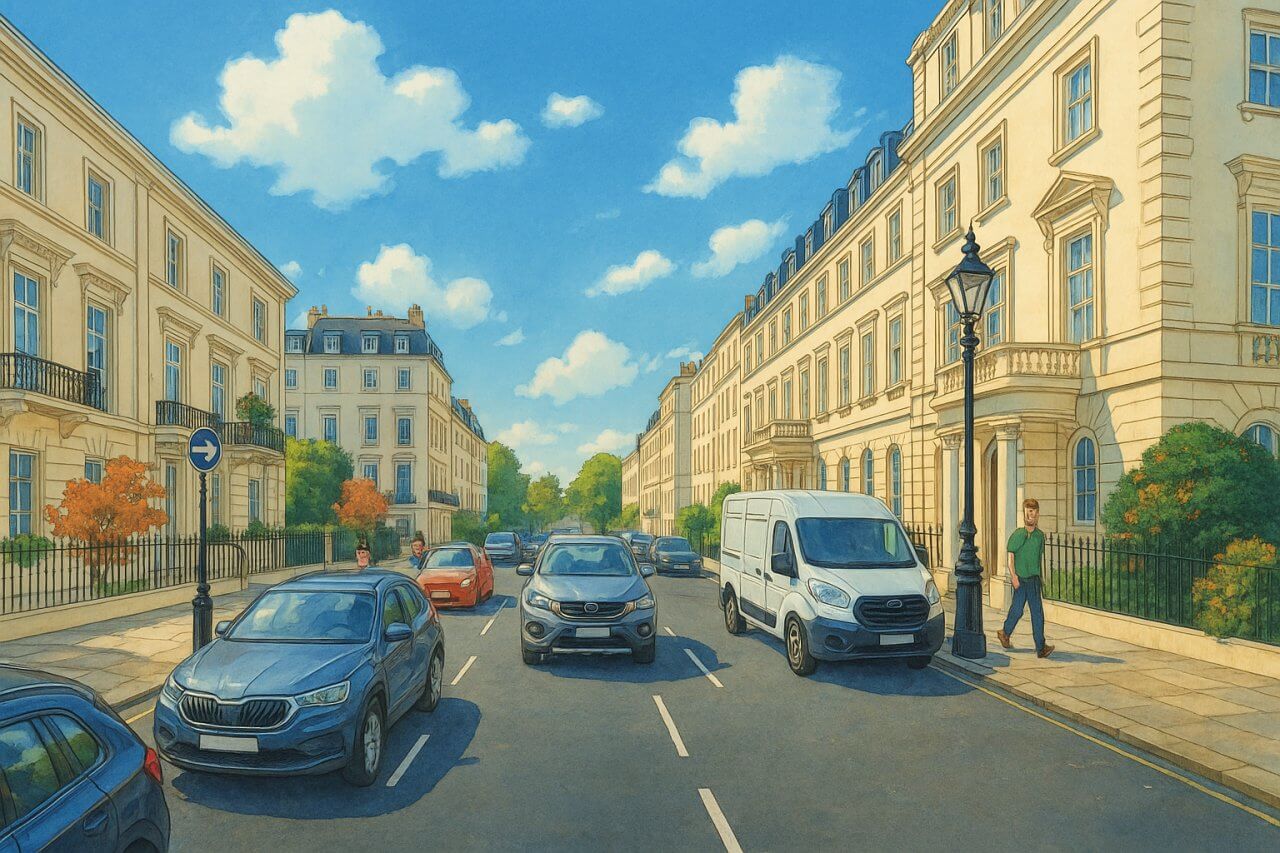
Belgrave Place, London
Belgrave Place is a distinguished street in the heart of Belgravia, one of London’s most affluent and architecturally unified districts. It stretches for approximately 273 metres (896 feet), running from the grand expanse of Belgrave Square in the northwest to Eccleston Street in the southeast.
Overview and Layout
The street forms a straight and formal link between two significant roads in Belgravia. The buildings on both sides are dominated by stucco-fronted terraced houses, typical of the area’s 19th-century architectural vision. Belgrave Place accommodates two-way traffic, although its residential nature means traffic is generally light and calm.
History and Development
Belgrave Place was developed during the early 19th century as part of the Grosvenor Estate’s Belgravia project, masterminded by master builder Thomas Cubitt. The development of Belgravia began around the 1820s, with Belgrave Place itself constructed in the late 1830s and early 1840s. The street was designed to be an extension of the elegant and elite atmosphere of nearby Belgrave Square.
The street was named after the Grosvenor family title, Viscount Belgrave, a courtesy title held by the heir to the Duke of Westminster. The name is pronounced “BELL-grayv” /ˈbɛl.ɡreɪv/. 
Character and Architecture
Belgrave Place is characterised by its white stucco terraces, tall sash windows, and uniform cornices. Many of the houses feature original wrought iron railings, porticoed entrances, and multi-storey façades. Most buildings are configured as four- to five-storey townhouses, often with additional lower-ground or basement levels.
The atmosphere is serene and stately, underscored by tree-lined pavements, discreet security, and limited commercial intrusion. The properties here are mostly residential, with some embassy or diplomatic presence in certain sections.
Streets connected to Belgrave Place
- Belgrave Mews South
- Belgrave Square
- Eaton Place
- Eaton Square
- Eccleston Mews
Notable Locations Nearby
- Belgrave Square – One of London’s grandest 19th-century squares, featuring statues, gardens, and diplomatic buildings.
- Eaton Square – Another prestigious square to the southwest, known for its beautiful gardens and elegant façades.
- Cadogan Place Gardens – Private gardens nearby, adding to the greenery of the neighbourhood.
- Victoria Station – One of London’s main transport hubs, just a short walk away.
Real Estate and Property Values
Belgrave Place is among the most sought-after addresses in London. As of early 2025, the average value of a five-storey townhouse on the street ranges from £12 million to £25 million, depending on the size, condition, and heritage listing of the property.
Typical houses range from 4,000 to 6,500 square feet (370–600 sq metres). This places Belgrave Place far above London’s average house price, which hovers just below £750,000 for all property types combined1.
Many of the properties have been refurbished with modern interiors while preserving their historic exteriors, making them appealing to international buyers, particularly from the Middle East and Asia.
Transport Links
Underground Stations
- Victoria Station (7-minute walk) – Served by the Victoria, District, and Circle lines.
- Sloane Square Station (10-minute walk) – Served by the District and Circle lines.
- Hyde Park Corner Station (15-minute walk) – Served by the Piccadilly line.
Bus Services
The nearest bus stops are on Eccleston Street and Grosvenor Place. These stops are served by routes:
- 11 – Fulham Broadway to Liverpool Street
- 24 – Hampstead Heath to Pimlico
- 211 – Hammersmith to Waterloo
Fun Fact
Belgrave Place was once home to the controversial writer and philosopher Aleister Crowley in the early 20th century. Known for his involvement in occultism and mysticism, Crowley’s brief residence here added a curious historical footnote to an otherwise conservatively genteel street2.
Quick Facts
- Location: Belgravia, City of Westminster, London
- Length: 273 metres (896 feet)
- Traffic Direction: Two-way
- Built: Late 1830s to early 1840s
- Name Origin: From Viscount Belgrave, Grosvenor family title
- Pronunciation: "BELL-grayv" /ˈbɛl.ɡreɪv/
- Architectural Style: White stuccoed terraces, Victorian townhouses
- Nearest Tube Stations: Victoria (Victoria, District, Circle), Sloane Square, Hyde Park Corner
- Nearby Bus Routes: 11, 24, 211
- Average Property Prices (2025): £12–25 million for full houses
- Notable Former Resident: Aleister Crowley (philosopher and mystic)
Who Were the Grosvenors, and How Did They Acquire This Land?
If you're wondering why so many streets and squares in this area bear names like Grosvenor, Belgrave, Eaton, or Wilton, it's because much of this land once belonged to the powerful Grosvenor family. To find out how they came to own vast swathes of Mayfair, Belgravia, and Pimlico — and whether they had any ties to the government or the royal family — read our in-depth article here.
References
Map of Belgrave Place, London

Painting of Belgrave Place, London (View image in full size)